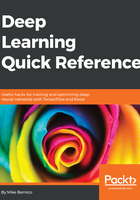
Visualizing training
Since we've written log data from both the models in Chapter 2, Using Deep Learning to Solve Regression Problems, we can use TensorBoard to compare the two models graphically. Open up TensorBoard and head to the SCALARS tab. You should see something like this. You may need to click loss and val_loss to expand the graphs:

If you look at the bottom-left corner of the screen, you should notice that each directory we created has a run associated with it. Both are currently selected. This means that on our graphs, we will see output for both models.
The default X scale on these graphs is epochs. The Y value is the loss function we chose, which was MAE. You can click on the graphs to explore them and drag to zoom.
Seeing the graphs like this, we can really see the relative bias and variance of each network. While there is a good separation between the models in train loss, the deep neural network only gets marginally better on the validation set, suggesting that we've headed into overfitting territory.